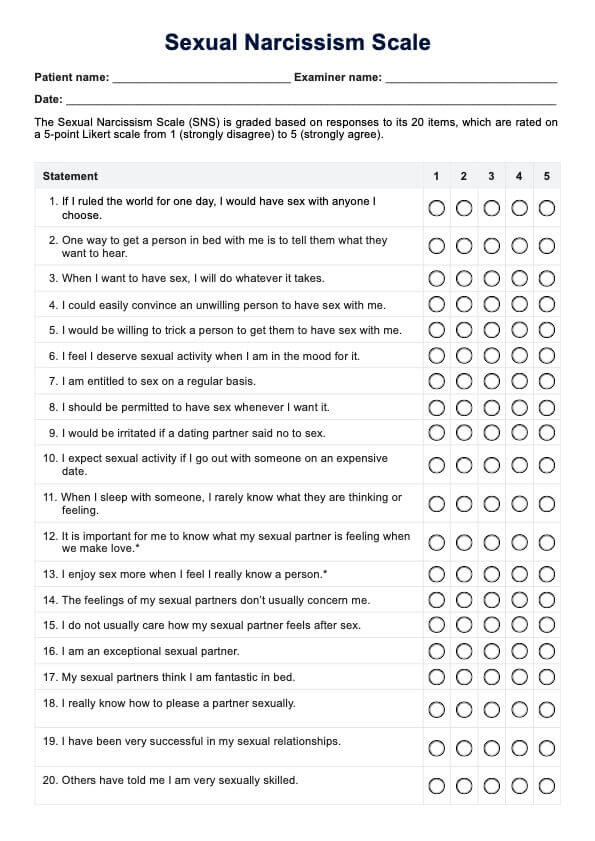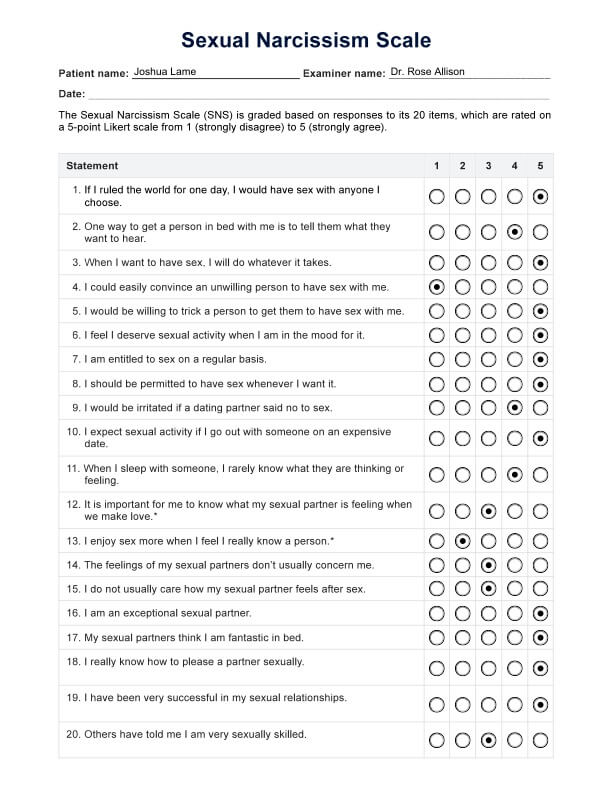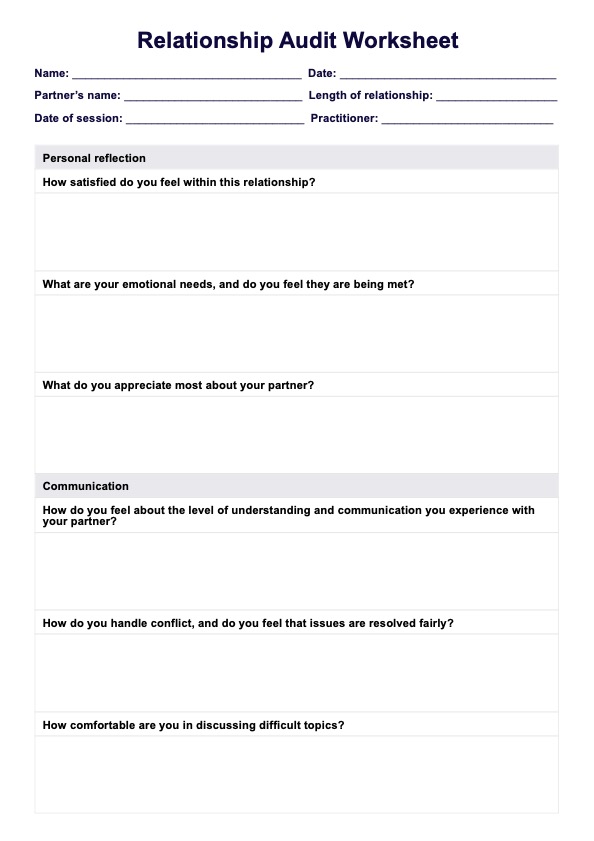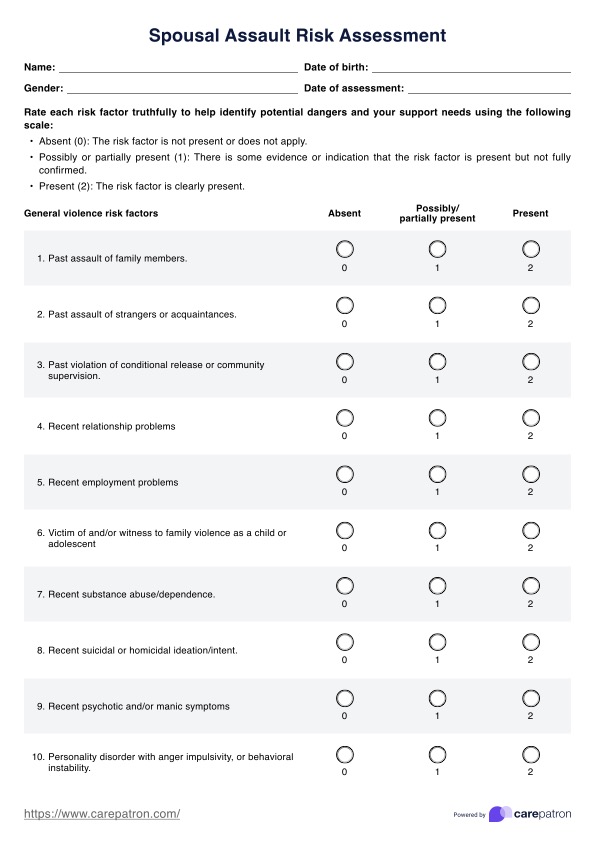Sexual Narcissism Test
Assess sexual narcissism and its impact with our Sexual Narcissism Test. Identify tendencies, guide interventions, and promote healthier relationships.


What is a Sexual Narcissism Test?
Sexual narcissism is a subtype of narcissistic personality traits centered around one's sexual relationships and self-perception as a sexual partner. Individuals with high sexual narcissism often exhibit sexual behaviors that prioritize their own gratification, often at the expense of their partner's needs or desires.
Symptoms of sexual narcissism can include an inflated sense of sexual entitlement, or that they expect or even deserve sexual activity or access. A sexual narcissist also lacks empathy toward sexual partners and believes that they are an exceptional sexual partner. This mindset can lead to manipulative behaviors, such as sexual coercion or disregarding a partner's consent, comfort, or sexual satisfaction.
The best way to quantify sexual narcissism behaviors is the Sexual Narcissism Scale (SNS), developed by Laura Widman and James K. McNulty in 2009. It measures sexual narcissism across four subscales: sexual entitlement, sexual exploitation, low sexual empathy, and sexual skill. The scale's developers also reported a significant correlation between a high SNS score and a high Narcissistic Personality Inventory (NPI) score (Widman & McNulty, 2009)—people with narcissistic personality disorder are more likely to display the traits being quantified by the SNS.
By evaluating these aspects, the SNS helps in identifying individuals who may possess high levels of sexual narcissism, which can lead to issues such as relationship dissatisfaction, sexual aggression, and long-term psychological effects on both the sexual narcissist and their partners.
Sexual Narcissism Test Template
Sexual Narcissism Test Example
How to use our Sexual Narcissism Test template
To effectively use our Sexual Narcissism Test template, follow these steps:
Step 1: Access the template
Begin by accessing the Sexual Narcissism Test template through the Carepatron app. You can click "Use Template" to open and customize it directly in the app, or "Download" to save a printable PDF version.
Step 2: Administer the scale
Administer the Sexual Narcissism Scale to the patient, ensuring they understand each statement. Have the patient rate each of the 20 items on a 5-point Likert scale, ranging from 1 (strongly disagree) to 5 (strongly agree). You can either let the patient answer the scale themselves as a self-report or administer it via an interview. After completion, tally the scores for each statement and calculate the total score.
Step 3: Discuss the results and implications
Once the test is completed and scored, review the results with the patient. Discuss what the scores indicate in terms of sexual narcissism and its potential impacts. Use this discussion to guide further evaluation or treatment as appropriate. Read the next section for the interpretation.
Scoring
After the patient completes the Sexual Narcissism Test, the next step is to score the responses. Each item on the scale is rated from 1 (strongly disagree) to 5 (strongly agree), and the total score is the sum of all the responses. Higher scores indicate a greater degree of sexual narcissism.
The test is divided into four subscales:
- Sexual exploitation: This subscale includes questions 1-5. A higher score here suggests a tendency to manipulate or exploit others for sexual gratification.
- Sexual entitlement: This subscale includes questions 6-10. A higher score indicates a belief that one is entitled to sex whenever desired, without considering the other person’s consent or feelings.
- Low sexual empathy: This subscale includes questions 11-15, with items 12 and 13 being reverse-scored. Higher scores here reflect a lack of concern for the partner’s feelings or experiences during sexual activities.
- Sexual skill: The sexual skill subscale includes questions 16-20. A higher score in this subscale reflects the individual’s belief in their own sexual prowess and skill and does not necessarily reflect their actual skill in practice.
Once you’ve tallied the total score and individual subscale scores, use them to assess the patient’s level of sexual narcissism. These scores can help guide further discussions or interventions.
Implications of a high sexual narcissism score
High scores on the Sexual Narcissism Test may indicate a heightened risk for problematic behaviors and negative outcomes in relationships. This can lead to significant relational difficulties, including reduced sexual and marital satisfaction, and even potential legal or social consequences.
More importantly, individuals with elevated scores, particularly in the sexual exploitation subscale and the sexual entitlement subscale, may have a greater tendency toward sexual aggression, unwanted sexual contact, and/or adversarial sexual beliefs. As such, the SNS can be used to predict future sexual aggression or assault.
Next steps after conducting this test
After completing and scoring the Sexual Narcissism Test, encourage clients to take the following steps to address the results and start on the journey to becoming a better sexual partner:
- Individual therapy: Engage the patient in therapy to explore underlying issues contributing to sexual narcissism. Techniques such as cognitive-behavioral therapy (CBT) can help identify and change harmful thought patterns.
- Couples’ therapy: If applicable, couples’ therapy can address the impact of sexual narcissism on the relationship, improving communication and fostering a healthier sexual dynamic.
- Psychoeducation: Educate the patient about sexual narcissism and its effects on relationships to help them make informed decisions and develop healthier patterns.
- Behavioral interventions: Implement strategies to reduce harmful behaviors, such as promoting empathy and setting boundaries.
- Ongoing assessment: Regularly monitor the patient’s progress to ensure that interventions are effective and adjust as needed.
These steps aim to manage sexual narcissism effectively and promote healthier relationships.
Reference
Widman, L., & McNulty, J. K. (2009). Sexual narcissism and the perpetration of sexual aggression. Archives of Sexual Behavior, 39(4), 926–939. https://doi.org/10.1007/s10508-008-9461-7
Commonly asked questions
Hypersexual narcissism is characterized by an excessive preoccupation with sexual conquests and the need to affirm one’s self-worth through sexual activities.
A narcissist may treat his wife with manipulation, control, and a lack of empathy, often prioritizing his needs over hers. These behaviors may also manifest in sexual behaviors or during sexual intercourse.
Yes, living with a narcissist can be emotionally and mentally draining due to their constant need for attention, control, and validation.
A sexual narcissist often exhibits behaviors such as entitlement to sex, disregard for their partner’s feelings, and a focus on their sexual prowess.




















-template.jpg)



















































































